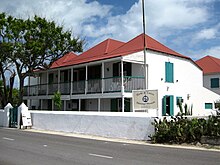
Back Turks i kajkos kreolski engleski Croatian Lenga créola anglèisa ëd Turks e Caicos PMS Turks ve Caicos kreolu Turkish
This article needs additional citations for verification. (February 2017) |

| Turks and Caicos Creole | |
|---|---|
| Native to | Turks and Caicos Islands |
Native speakers | 34,000 (2019)[1] |
English Creole
| |
| Language codes | |
| ISO 639-3 | tch |
| Glottolog | turk1310 |
| Linguasphere | 52-ABB-ao |
Turks and Caicos Creole, or Caicosian Creole, is an English-based creole spoken in the Turks and Caicos Islands, a West Indian British overseas territory in the Lucayan Archipelago.
The Turks and Caicos Island Creole variety has not been thoroughly studied but is a dialect of Bahamian Creole. It is also related to Bermudian Creole as the two are reportedly highly mutually intelligible. As of 1995, the number of speakers of Turks and Caicos Islands Creole was thought to be around 10,700, although decreasing and endangered.[2][3] It seems to be shifting to a variety form of Caribbean English, as Turks and Caicos Islands Creole does not have an official status. The use of African sounds and words in Caicosian Creole is similar to Gullah Geechee in South Carolina and Georgia, resembling elements of West African languages in Senegal and Sierra Leone. This is due to enslaved Africans brought to the island form South Carolina and Georgia between 1720–1750.[4][5][6]
Turks and Caicos Island Creole is also influenced by Jamaican Patwah—and shares many of the same words such as Aks (Ask), Dis (This), Gyal (Girl), and Mosi (Must be)[7]—due to the fact that the Turks and Caicos Islands were formally a part of Jamaica for over 114 years (1848–1962), and shares a common heritage with Jamaica.[8][9][10] Bermudian Creole has impacted Caicosian Creole because the islands were initially settled by Bermudian salt-rakers following British colonization, and were a de facto part of Bermuda for over 126 years (1673 - 1799).[11][12] As of (2019) the number of speakers of Caicosian Creole is approximately 34,000.[13][3]
- ^ Turks and Caicos Creole at Ethnologue (18th ed., 2015) (subscription required)
- ^ Ethnologue report for Turks and Caicos Creole English
- ^ a b "Statistics Department | Government of the Turks and Caicos Islands". www.gov.tc. Archived from the original on 27 February 2019. Retrieved 2024-03-05.
- ^ Klein, Thomas B. (2011-03-31). "African Sounds in Gullah Geechee and on Middle Caicos". The Black Scholar. 41 (1): 22–31. doi:10.5816/blackscholar.41.1.0022. ISSN 0006-4246.
- ^ Aceto, Michael (2008-12-19), "Eastern Caribbean English-derived language varieties: phonology", Eastern Caribbean English-derived language varieties: phonology, De Gruyter Mouton, pp. 481–500, doi:10.1515/9783110197181-033, ISBN 978-3-11-019718-1, retrieved 2024-10-06
- ^ Cawley, Charles (2015). ″Colonies in Conflict: The History of the British Overseas Territories.″ Newcastle: Cambridge Scholars Publishing. pp. 321 - 322.
- ^ Cassidy, F. G., Le Page, R. B. (2007). Dictionary of Jamaican English. (Second ed.). Cambridge: Cambridge University Press. pp. 253, 305.
- ^ Lucas, C. P. (1905). ″A Historical Geography of the British Colonies.″ Vol. 2. Oxford: Oxford University Press. p. 134.
- ^ Cawley, Charles (2015). ″Colonies in Conflict: The History of the British Overseas Territories.″ Newcastle: Cambridge Scholars Publishing. pp. 323 - 326.
- ^ Keegan, William F., Hofman, Corinne L. (2017). ″The Caribbean before Columbus.″ Oxford: Oxford University Press. pp. 151 - 195.
- ^ "Gold Bermudians - The Unheard Voice of Mary Prince". In Her Words - The Unheard Voice of Mary Prince. Dr. Dana Selassie. 2024. Retrieved 2024-08-07.
- ^ Cawley, Charles (2015). ″Colonies in Conflict: The History of the British Overseas Territories.″ Newcastle: Cambridge Scholars Publishing. pp. 315 - 320.
- ^ Ethnologue report for Turks and Caicos Creole English